UPDATED: January 9, 2023
You have had a water softener for quite a long time now, and it worked great. But lately, you’ve noticed a few changes that make you think that it may be time to consider getting a new one. Is it time to look for a new water softener? When does a water softener need to be replaced?
A water softener can usually be repaired, rather than replaced. Only when the control valve wears out, or your water characteristics have changed should you consider replacing it. Even if the control valve is not worth repairing, it can often be replaced, rather than replacing the entire system.
Just because your water softener is making a noise that you don’t remember hearing before, or it seems to be using more or less salt than it used to, doesn’t mean that it needs to be replaced. Here are some things to consider before ordering a new water softener.
When should you consider getting a new water softener?
Since a water softener will typically only last about 10 – 15 years, when any significant repairs may be required, you may be better off replacing the entire system rather than dealing with ongoing expensive repairs.
If your control valve needs an overhaul or complete replacement you may want to consider replacing your water softener.
Your water softener is mostly just a tall tank with water-softening resin in it, and a big tank that the salt sits in. But the most important (and hardest working part) of your water softener is its control valve.
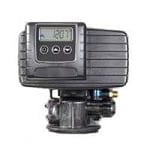
The control valve is where all the action happens. This is the brain of the water softener, the part that controls everything that the water softener does. If it isn’t working correctly, the entire system will not work correctly.
Even the best water softeners will generally only last between 10 and 15 years before the control valve will need a considerable amount of parts replaced to the point where it simply is not worth the expense to repair it.
There are a few different types of control valves on the market today, and most of them work very well when they are new, but over time, the internal parts will wear, and the main parts will need to be replaced.
If you are a do-it-yourself kind of person, this may be a good reason why you should NOT replace your water softener just yet.
For anyone who is a bit mechanically inclined, changing a few small parts every now and then could keep your water softener operating fine for many years before any major repairs would be necessary.
And when the time comes that your water softener will need a major repair like a main piston replacement, you will already be comfortable working with your water softener so changing the main piston could just be a simple 1-hour job.
A water softener needs to be replaced when the control valve can no longer function or be repaired at a cost that is near the cost of a new water softener. The valve of most water softeners can usually be repaired at a reasonable cost without having to replace the entire water softener.
Can I do major repairs on my water softener?
We have to first understand that a water softener control valve is a mechanical device that controls the water flowing through the system.
The water is under pressure, and therefore, the control valve has to work very hard to move its primary parts to control the flow of water.
Most water softeners have a piston that moves back and forth and diverts the water through different openings for each cycle that the water softener needs to go through to soften your water. If this position can no longer move smoothly, it may need to be replaced.
On some water softeners, replacing the main piston is actually quite easy.
It entails getting a new piston and seal stack (the seals that go around the piston) and then just replacing them.
Then remove the old piston (pretty easy, just pull it out), remove the old seals (a little more difficult as they sometimes break apart because they have gotten old and brittle, but still not too tough to do), and then add some silicon-based lubricant to the seals and piston and put the new ones in.
I have found that once the piston and seals are replaced, the valve can work perfectly fine for many more years, but a new piston and seal rebuild will generally not last as long as the original parts because of the other parts that work along with them have worn out as well.
What parts of a water softener are simple to fix yourself?
Most of the parts on a water softener that wear out or can cause the system not to work correctly can be replaced or even just cleaned, and the system will work fine again.
The most common parts that can affect a water softener’s ability to operate correctly are filtering screens and brine injectors.
These will look slightly different from one brand to another, but they do the same general functions.
First, the filtering screen is there to prevent small particles from getting lodged in the injector. Even a small particle of debris can prevent an injector from drawing the saltwater (brine) from the water softeners’ salt tank.
Iron in your water can build up inside the center of the injector and restrict its flow. After a while, the build-up can get to the point where the injector is no longer able to draw any saltwater at all. If this happens, the water softener will no longer be able to soften your water.
The injector creates a vacuum to draw out the saltwater that the water softener uses to clean away hard minerals that the softening resin has removed from your water. If it gets restricted or clogged, it can and therefore, the resin will not get cleaned.
Can I clean or replace the screen and injector?
Absolutely! In most cases, the screen can be cleaned with a little water and an old toothbrush. And the injector can be brushed off and cleaned with a mild solution of iron remover. Then brush it clean until you can see through the tiny hole in the center.
I do not recommend using any strong or toxic cleaners on either the screen or injector. The injector has rubber O rings on it that can get damaged by corrosive cleaners, even an iron-out solution should not be left on the O rings for a long period of time.
Once the screen and injector have been cleaned, put a small amount of silicon-based lubricant on the O rings of the injector to allow it to seal better when you replace it with the water softener. Do not use petroleum jelly, it will ruin the O ring over time.
Flush out the opening where the screen and injector sit with some clean water before re-inserting them, clean the cover, and then replace them in the water softener, and do not over-tighten the cap.
If your water softener still isn’t using much salt after a few weeks, check the screen and injector again as there may have been some debris elsewhere in the valve that has clogged the injector again.
There are very few other parts that can cause your water softener to stop working correctly. Most of the time, if a water softener has stopped softening your water, it has stopped using salt, and if your water softener has stopped using salt and the brine tank is full of water, it is usually because of a clogged injector.
For more details on servicing your water softener, see my articles:
“Do water softeners need regular service?”
“Do Kinetico water softeners need servicing?“
“How To Service Your Water Softener“
Have you noticed a drop in your water pressure?
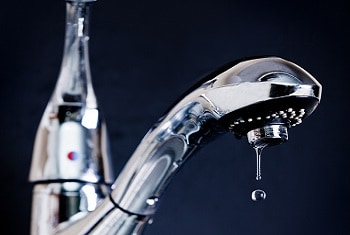
A drop in your home’s water pressure does not necessarily mean that you should replace your water softer, but it may be a sign that there is a significant problem with your water softener or part of your water treatment system.
First of all, check your whole house water filter to see if it has become clogged, if so, simply putting in a new filter cartridge may be the solution to your drop in water pressure.
If you find that your water filter cartridge is just fine and you still have poor water pressure, bypass your water softener to see if this solves your poor pressure problem.
Bypassing your water softener means that your water will be diverted from going through your water softener. Your water will simply go from the inlet pipe to your water softener directly to the outlet pipe of your water softener.
Bypassing your water softener will help you determine if your water softener is a possible cause of your loss of water pressure in the home.
There are several types of water softener bypasses. Most of the time, your water softener will come with a bypass that will be located where your home’s incoming cold water supply is connected to your water softener.
The bypass may be in the form of a single leaver that turns one-quarter turn, a knob that opens and closes, two knobs that turn one-quarter turn, a horizontal piston that you can push from right to left, a single leaver that turns all the way around or in some cases you may have three levers that need to be turned one-quarter turn to bypass the water softener.
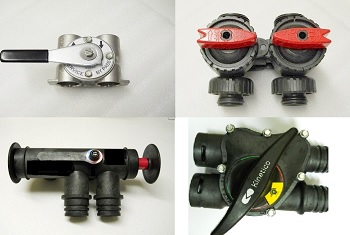
Once you have put your water softener into bypass mode, check your water pressure in the home. If you see a dramatic improvement in the water pressure, your water softener could be running water through it when it is not supposed to be.
This is often caused by valves in the control head sticking or not closing completely. This could lead to an expensive valve rebuild or valve replacement which may not be a wise investment in an old water softener.
Do you have chlorine in the water?
Chlorine is commonly used to disinfect water for municipal water supplies.
This is great to make your water safe, but chlorine will ruin the water softener resin in a standard water softener.
If you get your water from a municipal water supply that uses chlorine to ensure that your water is safe to drink, a standard water softener may lose its ability to soften your water because chlorine can deteriorate the water softener resin and make it ineffective at removing hard minerals from your water.
This will normally not happen for several years depending on the amount of chlorine in your water, but over time, the chlorine will cause the water softener resin to no longer be able to soften your water and will need to be replaced or you may choose to use a water softener that is designed for chlorinated water.
Signs that your water softener just needs to be serviced.
Is the water level in your salt tank very high?
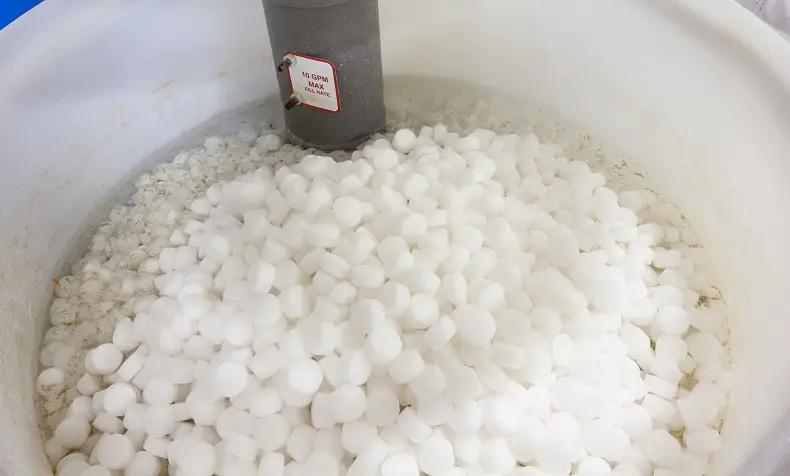
The water level in your water softener brine tank is higher than you remember it being and you think that that means that your water softener is finished! In many cases, this is not at all the case.
In most cases, high water in your brine tank simply means that your water softener is not drawing out the water as well as it should because of a blockage of a tiny hole in a small part inside of your water softener called an injector or venturi.
This part may not look the same on every water softener but its function is to create a draw that pulls the brine from your brine tank into the water softener tank to regenerate the water softener resin.
If this injector gets clogged or build-up inside the part blocks the tiny hole in this part, it will have difficulty drawing the water from the tank and therefore leave some water behind and the level of the water will be higher than it is supposed to be.
Your local water softener will be able to clean or replace the injector of your water softener along with the screen that blocks debris from clogging the injector which in many cases will allow your water softener to draw all of the water from your brine tank and refill it to the proper level.
Do you have salty-tasting water?
Getting a little salty-tasting water once in a while does not mean that your water softener needs to be replaced.
But if you have had your water softener serviced and it is using salt steadily but you are tasting salt in your softened water regularly but not in your un-softened water, there may be a problem in your water softener valve that may not be worth repairing if your water softener is 10 years old or more.
In many cases, salty-tasting water from a Kinetico water softener is caused by poor water pressure caused by a clogged pre-filter.
In some cases, your water may taste salty just in the morning and a simple service call may solve the problem.
But if your softened water has a salty taste most of the time, there may be salty water seeping through the water seals inside of the control valve which may require an expensive rebuild, and replacing the unit with a new water softener may be a wiser option.
Is your water softener not using as much salt as it used to?
A water softener needs a strong dose of brine (salt water) from the brine tank to regenerate its water softener resin. If your water softener doesn’t seem to be using as much salt as it used to, the water softener resin is not getting regenerated as well as it should.
You may still have soft water most of the time, but without enough brine, you are probably getting some hard water before the water softener knows to regenerate.
This is often due to a clogged injector that can be remedied with a simple service call from a water softener professional. A clogged injector does not justify the replacement of a water softener since an injector can easily be replaced on most water softeners.
Is your water softener using more salt than usual?
Many people think that if a water softener starts to use more salt than it used to that there must be something major wrong with it and it will need to be replaced.
In fact, I have found that MOST OF THE TIME you are just using more water than you used to so the water softener needs to regenerate more often than it used to, your water softener settings are incorrect due to a power outage or the water softener is simply using more salt for each regeneration than it needs to.
This is often corrected by re-testing your water for hardness and iron and making sure that the water softener is only regenerating when it needs to and with the correct dose of salt.
A trained water softener professional will test your water and reset your water softener to the correct settings for your water characteristics. There is most likely no major problems with your water softener, it just doesn’t know that it is using too much salt.
Are you getting hard water spots on dishware, faucets, and shower doors?
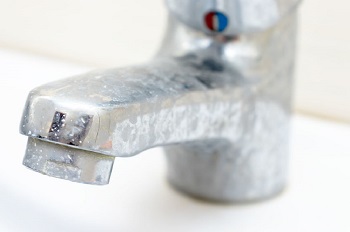
Water that is free of hard minerals will normally not leave any white staining on your water fixtures or glassware. Since most people do not examine their sinks or glasses every time they clean them, gradual staining can often go unnoticed.
Your water may be perfectly soft most of the time, but if you wash your dishes with slightly hard water every few washes, they may develop hard water staining over time.
This is often due to your water softener not operating properly and it may just need to be serviced.
Do you see yellow or orange “iron” staining?
You may see a yellow or orange stain on your sinks or bath if you have iron in your water but a properly operating water softener is very effective at removing iron from your water.
If you have started to see yellow or orange stains in your sinks, showers, or on your water fixtures, your water may have been removing the iron in your water but is now no longer able to.
A properly set water softener can remove a considerable amount of iron from your water, but as the water softener resin gets older, it can become less effective at removing iron and softening your water.
Your water may still feel like it is soft even if it is not removing all of the iron from your water.
If a water softener is working but not softening your water 100% all the time, the water may seem just fine but iron may be getting through your water softener just because it is not working as well as it should.
Other signs that your water softener may not be removing all of the iron in your water can be a yellow tint on your white laundry or dingy-looking laundry.
Iron will make white laundry look yellow and bright colors look less bright. Hard water will make your laundry detergent less effective at cleaning your laundry and your clothing can feel less soft even if you are using the same detergent that you have always used.
This can come on very slowly so some people simply think that their clothing is getting older and therefore losing its luster when actually your water softener may just need to be serviced so that the water that your washing machine is using will do a better job at cleaning your clothes.
A water softener professional will test your water for hardness as well as for iron in your water and will often be able to make sure that your water softener is set to remove your water hardness as well as the iron in your water.
Does your water feel different from one day to the next?
Irregular feeling water does not always mean that your water softener is getting old and can’t soften your water as well as it used to, it may just mean that it needs a few of its parts cleaned and its settings may be incorrect to properly soften your water.
Occasional itchy skin or dry hair may be signs that your water softener is not providing 100% soft water all of the time just because it needs to be serviced to enable it to soften your water correctly.
Do your dishes sound “squeaky clean”?
That “Squeaky” sound that you may hear when you run your finger over your dishes is actually an indication that you have hard water.
When you wash your dishes with soft water, your finger should slide smoothly over your dishes without any squeaky sound.
But don’t go out and start looking for a new water softener just yet!
Your water softener may simply be needing its settings checked and a simple adjustment made. You may need to have your water softener serviced by a professional or you may first simply increase the hardness setting on your water softener.
How you can test if your water softener is working properly.
Naturally, a water softener should be softening your water so the easiest way to know if your water softener is still operating correctly is to test if your water is soft.
If you have had your water softener for a long time, you will know the difference between hard water and soft water. Most people who have water softeners will know right away when their water is no longer soft.
You will notice that the soap that you have always been using doesn’t seem to be lathering as well as it used to. Chances are that it is not the soap, it is because your water softener is not softening your water properly.
By actually testing your water with a water hardness test kit, you will know for sure if your water softener is still softening your water, or if your water softener may need to be replaced.
But if your water test results indicate that your water is not 100% soft, that doesn’t mean that you have to run out and replace your water softener just yet. If your water test says that your water is just slightly hard (3 Grains Per Gallon), your water softener is probably working just fine, it may just need to be serviced to get it back to 100%.
But if your water test results show that the water coming out of your water softener is more than just a few grains per gallon and you have recently had it serviced by a water treatment professional, it might be time for you to replace your water softener.
Be sure to test your water for several days in a row!
Just because you tested your water on Sunday and it showed that you had slightly hard water does not mean that you are running hard water throughout your home all the time.
If your water softener is only set to regenerate on Monday nite, you could very well run into some degree of hard water by Saturday or Sunday, then when your water softener regenerates on Monday nite, you may have soft water again from Tuesday right through Sunday as usual.
Heavy water usage due to guests coming over, filling a swimming pool, watering the lawn, etc. can cause you to run into some hard water sooner than normal and does not necessarily mean that your water softener is only set to regenerate on certain days is not keeping up and needs to be replaced.
Even a metered water softener that keeps track of your water usage and will regenerate as needed depending on how much water that you use can allow some hardness into your water as it comes closer to its programmed water limit.
If you use an excessive amount of water the day before your metered water softener is planning to regenerate, you could very well find some hard water during the day before it regenerates.
By increasing the hardness setting of your water softener by 3-5 grains of hardness, this will tell your metered water softener to regenerate a little sooner than is absolutely necessary which will help to ensure that you never run out of softened water.
What you can do to prolong your water softener’s life.
Because a water softener is composed of many moving parts, the natural wear and tear of the system will require new parts from time to time, and eventually, your water softener will simply not be worth repairing.
But there are some simple things that you can do to help avoid replacing your water softener sooner than needed.
Change your water softener pre-filter often.
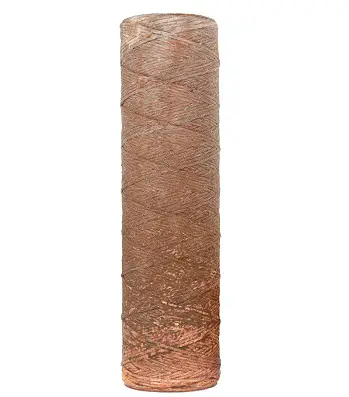
Having a water pre-filter before your water softener is not always needed, but if you have one in your home, it is there to protect your water softener from sediment and debris getting into your water softener and causing problems.
Dirt and grit can cause premature wear and tear to the components of your water softener which can lead to replacing your water softener sooner.
By changing your water pre-filter often enough, you are preventing extra wear and tear to your water softener parts and keeping dirt and debris out of your water softener resin.
Some people have municipal water and use an activated carbon pre-filter to remove chlorine that has been used to disinfect their water.
Chlorine can damage your water softener resin which will affect its ability to soften your water and may lead to having to replace your water softener.
An activated carbon filter can only remove chlorine from your water for so long. If the whole house carbon filter that you are using should be replaced every 3 months, then you should be diligent about changing it every 3 months to protect your water softener resin from the chlorine in your municipal water.
Give the inside of your water softener a cleaning once a year.
The easiest way to do this is by simply adding a single dose of water softener resin cleaner into your water softener brine tank once every year. THAT’S IT!
Water softener resin cleaner is a mild cleaner that you pour into your water softener brine tank so your water softener will run it through its water softener resin the next time that it regenerates. Then it will rinse the cleaner away, and you are done.
Make sure that your water softener is not regenerating too often, or not often enough.
Service your water softener on a regular basis depending on your water situation.
Not all water softeners are the same and your water softener may need to be replaced sooner than someone else’s simple because it has to deal with more hardness in your water, iron in your water, or simply because there is more water used in your home.
But if you find that your water softener doesn’t seem to be softening your water as it once was, it may just need to be serviced, and as it gets older, it may need to be serviced more often than it used to, to provide you with quality water.
A little hard water from an older softener may not mean that you need to replace it, it may just mean that it will need to be serviced once a year where it used to have to be serviced every several years.
Test your water hardness more often as your water softener gets older, and increase the frequency of regeneration of your water softener if needed.
Your water softener might need to work a little harder as it gets older, but that doesn’t mean it has to be replaced right away.
As water softener resin gets older, it can lose its ability to remove hard minerals from your water. This doesn’t mean that your whole water softener needs to be replaced, you may just have to set your water softener to regenerate more often to provide the soft water that you need.
When a water softener regenerates its water softener resin, it does not completely regenerate all of the resin in the water softener tank.
Because of the high amount of salt that would be required to regenerate the resin completely, it is much more efficient for the water softener to only regenerate its resin by about 25%.
So when your water softener resin gets a little older and is not able to remove hard minerals from your water as well as it used to, you can simply increase the hardness setting on your water softener so it will regenerate the resin more often so it can still soften your water.
When should you call your water treatment professional for repair rather than replacement?
If you’re not particularly handy or mechanically inclined, you should call your water treatment professional for your regular servicing and they should take care of everything.
But if you are pretty handy and would like to save a few dollars by maintaining your water softener yourself, you may only need to call a water treatment professional when there are serious issues with your water softener.
Changing or cleaning the screen and injector on a water softener is not rocket science, you just have to use some common sense and follow some basic water softener servicing instructions.
If you have already done your regular water softener maintenance yourself but you find that your water softener is still not working correctly, you may want to call your water treatment pro to dig a little deeper into why your water softener is not working correctly.
Changing a piston or taking apart certain areas of a standard water softener can be a bit confusing unless you have some experience with how a water softener really works.
Other than regular maintenance, letting a pro do what they have trained for might be the best option if your water softener is having serious problems but it is usually a good idea to have a pro look at your water softener before deciding to replace it.
When is a water softener NOT worth repairing?
Any water softener can be repaired as long as the parts that are required are available to fix it! But you have to make a decision that at some point “Is It Really Worth Repairing My Water Softener, Or Should I Replace It”.
I find that this decision is often based on the price of the repair needed compared to the price of a brand new water softener and the age of the water softener.
The life expectancy of a typical water softener is about 10 to 15 years of average use. After that, you may start to run into replacing the water softener resin in the tank, replacing the main piston of the system, re-building the control valve, or replacing the control valve altogether.
If you can do these repairs yourself, the cost may be very reasonable depending on the type of water softener that you have, but if you need to have your water treatment professional do these repairs, it can turn into a substantial expense.
Replacing water softener resin can cost $400 and up. Replacing major parts of a water softener can start at about $300 depending on which parts need to be replaced and you can expect to pay $500 to over $1000 for a new control valve.
If you have particularly bad water that requires several pieces of special equipment to make your water better, several hundred-dollar repairs may be the way to go to get the most out of the expensive equipment that you have purchased.
But if the only issue with your water is hardness, you can replace your water softener with a brand new one for just a few hundred dollars more than the cost of a major repair.
If you are just reasonably handy, you can get a new high-quality water softener that will soften your water just fine, and you will have the peace of mind of knowing that you will have many years of reliable service from it with minimal maintenance.
Replacing a water softener can be a major purchase and the decision to replace it should not be taken lightly. Having a reliable water softener is a big part of maintaining the plumbing and water appliances in your home.
Testing your water to know if your current water softener is still working correctly is a simple way to determine if your water softener may need to be replaced but a little hard water here and there does not necessarily mean that it is time to replace your water softener, so consider the age of your water softener and potential future repair costs and you should be able to make a wise decision on whether to repair or replace your existing water softener.
If you decide that it is finally time for you to replace your water softener, you can use this chart to determine the properly sized water softener for your needs.
Simply test your water to determine your level of water hardness, then find the best-sized water softener grain capacity for your situation.
| Your water hardness in Grains Per Gallon | Grain Capacity for 1 to 2 People | Grain Capacity for 3 to 4 People | Grain Capacity for 4 to 5 People | Grain Capacity for 5 to 6 People |
| 3 to 7 | 24,000 | 24,000 | 32,000 | 32,000 |
| 5 to 10 | 32,000 | 32,000 | 32,000 | 48,000 |
| 11 to 20 | 32,000 | 32,000 | 48,000 | 48,000 |
| 21 to 30 | 32,000 | 48,000 | 64,000 | 80,000 |
| 31 to 40 | 48,000 | 64,000 | 64,000 | 96,000 |
| 41 to 50 | 64,000 | 80,000 | 96,000 | 96,000 |
| 51 to 60 | 64,000 | 80,000 | 96,000 | 96,000 |

